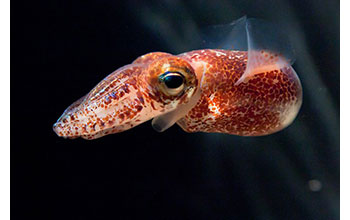Multimedia Gallery
Hawaiian bobtail squid (Euprymna scolopes)
The Hawaiian bobtail squid (Euprymna scolopes) is a night-active predator on the shallow reef flats of the Hawaiian archipelago. To hunt at night, this small animal uses light produced by a population of the bacterial symbiont Vibrio fischeri to camouflage against the moonlight and starlight. Such symbiosis -- the mutually beneficial relationship between different organisms -- is likely occurring in higher animals as well, including humans.
To learn more about this research, see the University of Wisconsin–Madison news story The color of blood: Pigment helps stage symbiosis in squid. (Date image taken: February 2012; date originally posted to NSF Multimedia Gallery: Aug. 16, 2017)
Credit: Chris Frazee/University of Wisconsin School of Medicine and Public Health
Images and other media in the National Science Foundation Multimedia Gallery are available for use in print and electronic material by NSF employees, members of the media, university staff, teachers and the general public. All media in the gallery are intended for personal, educational and nonprofit/non-commercial use only.
Images credited to the National Science Foundation, a federal agency, are in the public domain. The images were created by employees of the United States Government as part of their official duties or prepared by contractors as "works for hire" for NSF. You may freely use NSF-credited images and, at your discretion, credit NSF with a "Courtesy: National Science Foundation" notation.
Additional information about general usage can be found in Conditions.
Also Available:
Download the high-resolution JPG version of the image. (287.8 KB)
Use your mouse to right-click (Mac users may need to Ctrl-click) the link above and choose the option that will save the file or target to your computer.

